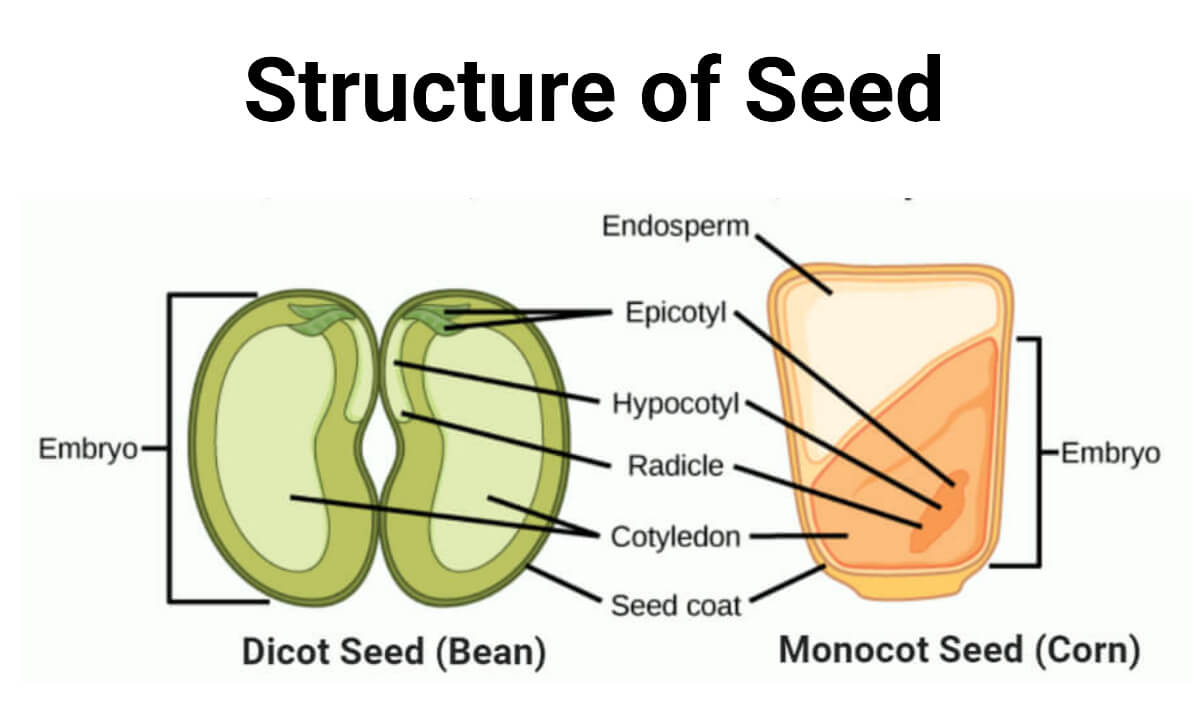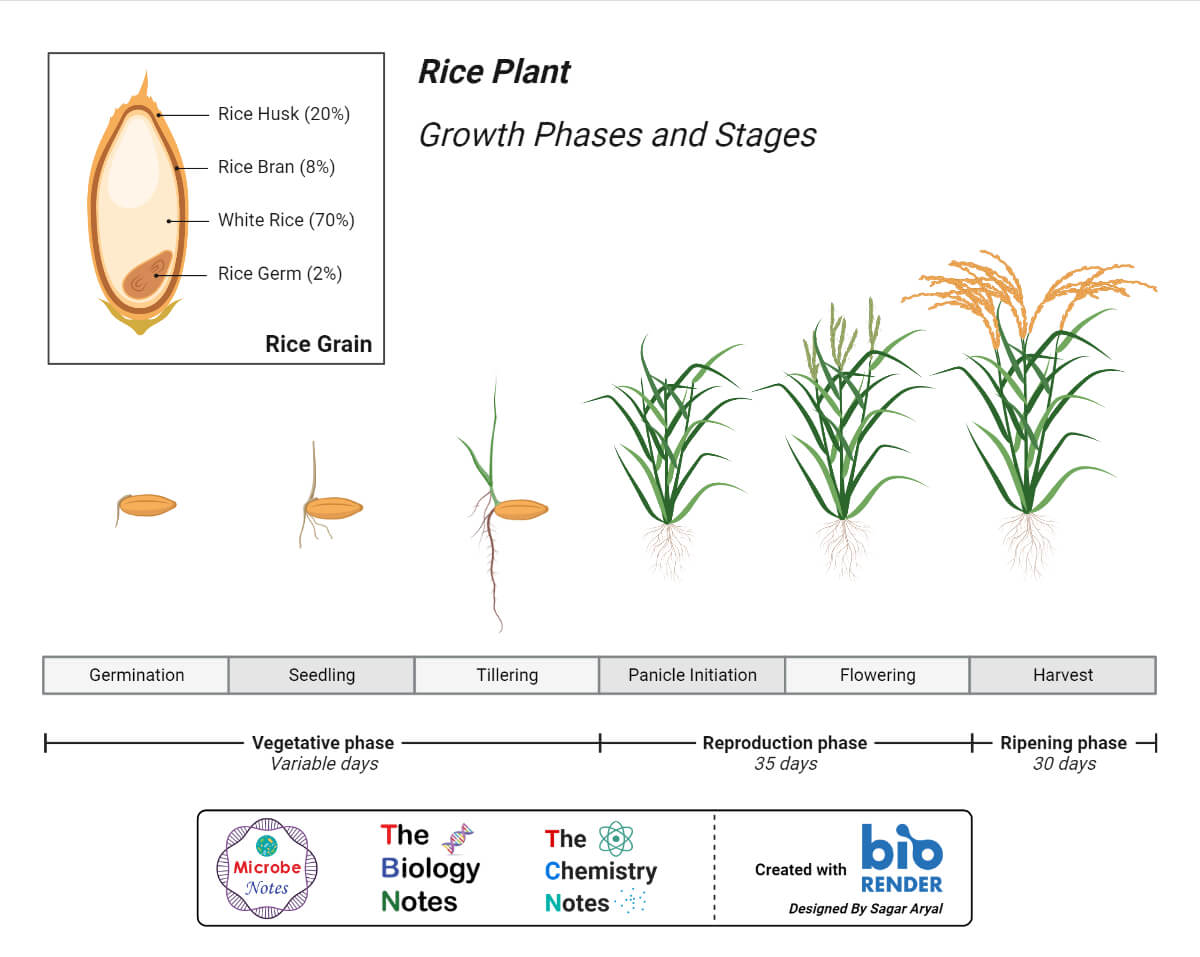A seed is the fertilized matured ovule that possesses an embryonic plant, stored food material, and a protective coat that is viable and can germinate.
A seed is a plant embryo in a dormant state and produced after the flower is fertilized. It is the reproductive structure of all flowering plants or phanerogams that have genetic wisdom and capability for perpetuation.

The growth of the seed into a plant is known as germination. It can resist stress conditions by perennation( surviving season) and remains viable until germination.
They are in a dormant state induced by desiccation and abscisic acid, during which growth and development are ceased until they are exposed to certain climatic and innate requirements.
Finally, it dispersed through many agents to the miles.
Seeds are also used as a source of food like cereal grains, source oil (mustard, sunflower, soybean), margarine production, lubrication oil from rapeseed, cotton, essential oil from juniper, stimulants from coffee, spices from pepper, etc.
Types of Seed
Classification of seeds based on the number of cotyledons
- Monocotyledonous seeds: Seeds having a single cotyledon. E.g. rice, orchid, maize, etc.
- Dicotyledonous seeds: Seeds having two cotyledons. E.g. pea, beans, mango, mustard, etc.
Classification of seeds based on the presence of endosperm
- Albuminous seed: Seeds in which endosperm is present and provides nutrition during the early development of the seed. In this type of seed, cotyledons are thin and membranous. E.g. Dicot: castor, cotton; Monocot: maize, wheat, rice
- Exalbuminous seeds: Seeds in which endosperm is absent, and food is stored in fleshy and thick cotyledons. At an early stage, food stores in endospermic tissue are utilized by the embryo resulting in a non-endospermic condition in mature seeds. E.g. Dicot: pea, bean, gram, etc.; Monocot: orchid
Structure of seed
Seeds generally consist of 3 parts: Cotyledons or embryonic leaves, the embryo from which growth commences, and the outer protective covering called the seed coat. However, the structure of seeds and their parts differ in dicot and monocot.
Structure of monocotyledonous seed
- Seed coat: The seed coat is membranous and attached to the fruit wall.
- Endosperm: Endosperm is a bulky storage organ that nourishes the growing embryo. Monocots are generally endospermic with few exceptions, like an orchid.
- Aleuron layer: It is the proteinous layer in between the outer membrane of endosperm and embryo that secretes the enzyme for the degradation of reserve food.
- Embryo: The embryo is a small fleshy body present in the groove at the end of the endosperm. The embryo is diploid. It consists of the following parts:
- Scutellum: This is the single large, shield-shaped cotyledon that nourishes the growing embryo
- Embryonal axis: They are radicle and plumule formed at two ends of the seed. The radicle grows downward and gives rise to the root of a new seedling, while the plumule grows upward and gives rise to a shoot or stem.
- Coleoptile and coleorhiza: Radicle and plumule are enclosed in a sheath called coleoptile and coleorhiza, respectively.

Structure of dicotyledonous seed
- Seed coat
It is developed from the integument of the ovule and has the following parts.
- Testa: It is the outer thick layer that performs a protective function.
- Tegman: It is an inner thin membranous layer that protects the inner layer of the seed.
- Hilum: It is the point on the seed coat from which the seed is attached to the endocarp of the fruit. It is equivalent to the naval of humans.
- Micropyle: It is the small round pore above the hilum for the entry of pollen tube, water, and oxygen into the embryo.
- Raphe: It is the ridge portion in the groove that remains fused with testa.
- Embryo
- Cotyledon: They are the fleshy structure present in the embryonal axis and provide nutrition for developing embryos. Dicot has two cotyledons.
- Embryonal axis: It is the miniature plant present in between the two cotyledons and consists of plumule and radicle, which later developed into shoot and root, respectively. The portion between cotyledon and radical is called hypocotyl, whereas the point between cotyledon and plumule is called epicotyl.
Read Also: Monocot vs Dicot Seed- Definition, Structure, 10 Differences, Examples
Seed size and shape
- Seed size, color, and shape may vary from smaller to large, wrinkled, hairy to smooth. The shape and size of the seed are important for dispersal, survival, and germination.
- The world’s smallest seed known are found in orchids that are devoid of reserve nutrient and lives in symbiosis with mycorhizal fungi, carnivorous plant, and parasitic plants. The seed of the double coconut palm is the largest seed known.
- In many plants, seeds are uniform in size, and seed size depends upon the genetic factors, e.g., wheat.
- In peas, the seed form on the central part of the pod is relatively larger because of the competition for the nutrient between ovules on the placenta.
- Seeds of Camelina sativa mimic flax seed size and nature that are grown in a particular region.
- The flatness of the seed restricts the germination of tropical mora, but the exception is seen in Panicum turgidum seed which can germinate from the convex side rather than flat.
Seed Development
- Seed development generally consists of 3 stages: cell division and differentiation, accumulation of food reserve, maturation, and water loss.
- Seed development generally starts from fertilization which is preceded by pollination.
- In angiosperm, the ovule consists of two-layer the integument and nucellus. The nucellus cell undergoes meiosis and mitotic division to form eight nucleated embryo sacs. Pollen tube enters unto embryo sac and releases two gametes. One male gamete unites with the egg cell to form a diploid zygote that later develops into an embryo, while the other gamete unites with two polar nuclei to form a triploid endosperm that stores food for the growing embryo.
- The integuments of ovule change to seed coat with two distinct covering; outer testa and inner tegman.
- In some cases, there may be remnants of nucellar tissues called perisperm that stores food, but in most cases, it disappears.
- Endosperm nourishes the embryo by storing food material. In albuminous seed, endosperm remains conspicuous and a greater part of the seed than the embryo, while in other seeds like Tectona, the embryo uses all nutrition in development, and endosperm may disappear by the time of maturity. In such cases, the cotyledon is the organ for storage.
- Embryo development may vary that we may distinguish all the parts of embryo-like cotyledon, plumule, radicle, etc. In some angiosperms, more than one embryo may be developed in a single seed called polyembryony.
- In gymnosperm, there is a single integument that is fused with an ovuliferous scale consisting of paired ovules. At fertilization, the nucellus is separated from the integument only in the micropyle region. Meiosis and mitosis in nucellus take place the same as in angiosperm and form female gametophyte (multicellular, haploid) that grows further, replacing nucellus and differentiated into archegonia, each consisting of two large egg cells.
- One of the two gametes from the pollen tube is fertilized with the egg cell to form a zygote that later develops onto the embryo, while another one is either aborted (in Pinus) or may fertilize with other archegonia but never unite with polar nuclei to form endosperm.
- The mature seed consists of a seed coat developed from the integument, diploid perisperm developed from nucellus e.g., Pinus pinea, but in most cases, it disappears during development, and the haploid gametophyte tissue which nourishes the embryo, which is equivalent to the endosperm of angiosperm and the last one is embryo consists of plumule, radicle, cotyledon same as an angiosperm. Cotyledon number may vary in gymnosperm up to 18 (in pinus).
Seed Germination
- Seed germination is the emergence of the essential characteristics from the embryo, which can give rise to new plants under the favorable condition of atmosphere and soil. All the viable seeds naturally germinate.
- Seed loss moisture at maturity with reduced metabolic activities and goes to a quiescent state that is reactivated by some climatic factors.
- There are three major events that occur during the germination process
- Water imbibition: When the seed is sown in moist soil, water is absorbed by the seed, which causes the seed to swell and split the seed coat.
- Enzyme activation: Following the intake of water, activation of some hydrolytic enzymes that hydrolyze food material and products are then translocated to the growing point, and increased respiration and assimilation rate provides energy for other processes.
- Cell division and enlargement: This process results in the emergence of plumule and radicle.
- Oxygen, water, and optimum temperature are the condition required for seed germination.
Types of germination
- Epigeal germination: Process in which young plant anchoring by the radicle is followed by the elongation of hypocotyl above the soil surface exposing cotyledon and plumule is later developed into primary shoot and leaves.
- Hypogeal germination: The process of germination in which cotyledon remains underground and elongation of plumule takes place. E.g., Monocots like rice, maize.
- Vivipary germination: Process in which seed germinates inside the fruit when it is still attached to the parent, and the radicle elongates and loses contact and falls into the ground and develops into a new plant.
- E.g., mangrove plants like Rhizophora and Sonneratia.

Seed Dispersal
Dispersion of the seed is defined as the dissemination and transport of seed from one place to another away from their parent plant by many external agents or on their own.
There are mainly six modes of dispersion.
- Barochory: It is the dispersion of seed by gravity. The heavier seed detached from the parent plant due to the effect of gravity which later either rolled down and buried in the soil or translocated by other means. E.g. fruits like apple, mango, coconut, etc.
- Anemochory: It is the dispersion of seed by the wind. Most of the lightweight seeds are transported by wind. E.g. dandelion, cottonseed, maple, orchid seed, etc.
- Hydrochory: It is the dispersion of seed by means of a water agent. The seeds having a flat and hollow structure that can easily float in the water are dispersed by this mode and distance travel depends upon the source of water. E.g. mangrove, water lily, etc.
- Zoochory: Dispersion of the seed by the animal is called zoochory. Endozoochory represents the mutualistic relationship in which birds and animals eat fruit as a source of food, and in the feces or dropping, seeds are disseminated. E.g. blueberry, tomato, cherry, etc., while epizoochory includes seed having spine hook that attached to the external surface of the animal and transported e.g. clover leaf, burdock plant, etc.
- Ballochory: This is the mode of dispersion in which the seed is forcefully ejected by an explosion when the fruit is ripe. The explosion is the result of turgor pressure or internal tension. E.g. dynamite tree, okra, lupin, etc.
- Anthropochory: Seed dispersal by the human is called anthropochory. These means have high mobility than other modes of dispersal. E.g. annual meadow grass, wild chamomile, stinging nettle, etc.
Functions of Seed
- Most flowering plants are reproduced by means of seed.
- Seeds contain embryos, and nourishment of the embryo helps them to develop into the new plant.
- Seeds disperse by various agents and establish in the new place.
- Seed undergoes a dormant state during an unfavorable environment.
- Seed helps to keep species in existence.
References
- Harper, J. L., Lovell, P. H., & Moore, K. G. (1970). The shapes and sizes of seeds. Annual review of ecology and systematics, 327-356.
- Bewley, J. D., & Black, M. (2013). Seeds: physiology of development and germination. Springer Science & Business Media.
- https://www.britannica.com/science/seed-plant-reproductive-part.
- https://medcraveonline.com/APAR/biology-of-seed-development-and-germination-physiology
- https://byjus.com/biology/seed-germination.
- https://www.embibe.com/exams/seeds
- https://www.cliffsnotes.com/study-guides/biology/plant-biology/the-shoot-system-flowers-fruits-seeds/seed-structure-and-development
- https://www.toppr.com/guides/biology/anatomy-of-flowering-plants/the-seed
